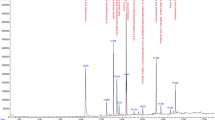Abstract
In our study, we investigated morphological abnormalities and overexpression of one of the stress genes (hsp70) at different concentrations of Aristolochia extract. The plant material and animal for study was collected. The plant was mechanically grinded to prepare the infusion. The shrimp were acclimatized in a laboratory. Aristolochic acid (AA) exposure at concentrations 6000, 12 000, 18 000, 24 000 and 30 000 ppm to shrimp after 48 h, led to morphological malformations at 18 000 ppm concentration. Expression analysis revealed that the transcription of hsp70 was higher in 24 000 ppm (72 h) exposed N. davidi relating to control. The data obtained from the current study helps in better understanding of aristolochic acid induced toxicity, thus indicating the regulation of herbal products containing aristolochic acid in high concentration.


Similar content being viewed by others
REFERENCES
Abhishiktha, S.N., Saba, S., Shrunga, M.N., et al., Antimicrobial and radical scavenging efficacy of leaf and flower of Aristolochia indica Linn., Sci. Technol. Arts Res. J., 2015, vol. 4, pp. 103–108. https://doi.org/10.4314/star.v4i1.17
Al-Badran, A.A., Fujiwara, M., and Mora, M.A., Effects of insecticides, fipronil and imidacloprid, on the growth, survival, and behavior of brown shrimp Farfantepenaeus aztecus, PLoS One, 2019, vol. 14, no. 10, p. e0223641. https://doi.org/10.1371/journal.pone.0223641
Bhattacharjee Payel, and Debasish Bhattacharyya, Characterization of the aqueous extract of the root of Aristolochia indica: Evaluation of its traditional use as an antidote for snake bites, J. Ethnopharmacol., 2013, vol. 145, pp. 220–226. https://doi.org/10.1016/j.jep.2012.10.056
Chen, C.-H., Dickman, K.G., Moriya, M., et al., Aristolochic acid-associated urothelial cancer in Taiwan, Proc. Natl. Acad. Sci. U. S. A., 2012, vol. 109, pp. 8241–8246. https://doi.org/10.1073/pnas.1119920109
Das, S., Mohapatra, A., and Sahoo, P.K., Expression analysis of heat shock protein genes during Aeromonas hydrophila infection in rohu, Labeo rohita, with special reference to molecular characterization of Grp78, Cell Stress Chaperones, 2015, vol. 20, pp. 73–84. https://doi.org/10.1007/s12192-014-0527-2
Gökmen, M.R., Cosyns, J.-P., Arlt, V.M., et al., The epidemiology, diagnosis, and management of aristolochic acid nephropathy: A narrative review, Ann. Intern. Med., 2013, vol. 158, pp. 469–477. https://doi.org/10.7326/0003-4819-158-6-201303190-00006
Gupta, S.C., Sharma, A., Mishra, M., et al., Heat shock proteins in toxicology: How close and how far?, Life Sci., 2010, vol. 86, pp. 377–384. https://doi.org/10.1016/j.lfs.2009.12.015
Han, J., Xian, Z., Zhang, Y., et al., Systematic overview of aristolochic acids: Nephrotoxicity, carcinogenicity, and underlying mechanisms, Front. Pharmacol., 2019, vol. 10, p. 648. https://doi.org/10.3389/fphar.2019.00648
Hu, X.L., Niu, J.J., Meng, Q., et al., Effects of two juvenile hormone analogue insecticides, fenoxycarb and methoprene, on Neocardina davidi, Environ. Pollut., 2019, vol. 253, pp. 89–99. https://doi.org/10.1016/j.envpol.2019.06.120
Jirovetz, L., Buchbauer, G., Puschmann, C., et al., Analysis of the essential oil of the aerial parts of the medicinal plant Aristolochia indica Linn. (Aristolochiaceae) from South-India, Sci. Pharm., 2000, vol. 68, pp. 309–316. https://doi.org/10.3797/scipharm.aut-00-28
Kanjilal, P.B. and Kotoky, R., and Couladis., M., Chemical composition of the stem oil of Aristolochia indica L., J. Essent. Oil Res., 2009, vol. 21, pp. 24–25. https://doi.org/10.1080/10412905.2009.9700098
Lerma-Herrera, M.A., Beiza-Granados, L., Ochoa-Zarzosa, A., et al., Biological activities of organic extracts of the genus Aristolochia: A review from 2005 to 2021, Molecules, 2022, vol. 27, p. 3937. https://doi.org/10.3390/molecules27123937
Liang, Z., Chen, T., Yang, F., et al., Toxicity of chronic waterborne zinc exposure in the hepatopancreas of white shrimp Litopenaeus vannamei, Chemosphere, 2022, vol. 309, p. 136553. https://doi.org/10.1016/j.chemosphere.2022.136553
Mahmood, K., Jadoon, S., Mahmood, Q., et al., Synergistic effects of toxic elements on heat shock proteins, BioMed Res. Int., 2014, vol. 2014, p. 564136. https://doi.org/10.1155/2014/564136
Mei, N., Arlt, V.M., Phillips, D.H., et al., DNA adduct formation and mutation induction by aristolochic acid in rat kidney and liver, Mutat. Res., 2006, vol. 602, pp. 83–91.
Parolini, M., Toxicity of the Non-Steroidal Anti-Inflammatory Drugs (NSAIDs) acetylsalicylic acid, paracetamol, diclofenac, ibuprofen and naproxen towards freshwater invertebrates: A review, Sci. Total Environ., 2020, vol. 740, p. 140043. https://doi.org/10.1016/j.scitotenv.2020.140043
Rungrassamee, W., Leelatanawit, R., Jiravanichpaisal, P., et al., Expression and distribution of three heat shock protein genes under heat shock stress and under exposure to Vibrio harveyi in Penaeus monodon, Dev. Comp. Immunol., 2010, vol. 34, pp. 1082–1089. https://doi.org/10.1016/j.dci.2010.05.012
Shibutani, S., Dong, H., Suzuki, N., et al., Selective toxicity of aristolochic acids I and II, Drug Metab. Dispos., 2007, vol. 35, pp. 1217–1222. https://doi.org/10.1124/dmd.107.014688
Siregar, P., Suryanto, M.E., Chen, K.H.-C., et al., Exploiting the freshwater shrimp Neocardina denticulata as aquatic invertebrate model to evaluate nontargeted pesticide induced toxicity by investigating physiologic and biochemical parameters, Antioxidants, 2021, vol. 10, p. 391. https://doi.org/10.3390/antiox10030391
Soniya, E.V. and Sujitha, М., An efficient in vitro propagation of Aristolochia indica, Biol. Plant., 2006, vol. 50, pp. 272–274.
Tian, Y., Niu, J., Zhu, Q., et al., Breeding of Tianfu broilers, Heilongjiang Anim. Husb. Vet. Med., 2021, vol. 6, pp. 36–41.
Venkateswara Rao, J., Kavitha, P., Jakka, N.M., et al., Toxicity of organophosphates on morphology and locomotor behavior in brine shrimp, Artemia salina, Arch. Environ. Contam. Toxicol., 2007, vol. 53, pp. 227–232. https://doi.org/10.1007/s00244-006-0226-9
Wang, X., Giusti, A., Ny, A., and Witte, P.A., Nephrotoxic effects in zebrafish after prolonged exposure to aristolochic acid, Toxins, 2020, vol. 12, p. 217. https://doi.org/10.3390/toxins12040217
Xu, D., Ran, C., Yin, L., et al., Acute and subchronic toxicity studies of aristolochic acid a in Tianfu broilers, Animals, 2021, vol. 11, no. 6, p. 1556. https://doi.org/10.3390/ani11061556
Yang, Li., Su, T., Li, X.-M., et al., Aristolochic acid nephropathy: Variation in presentation and prognosis, Nephrol., Dial., Transplant., 2012, vol. 27, pp. 292–298.
Author information
Authors and Affiliations
Corresponding author
Ethics declarations
Conflict of interest. The authors declare that they have no conflicts of interest.
Statement on the welfare of animals. All applicable international, national, and/or institutional guidelines for the care and use of animals were followed.
Rights and permissions
About this article
Cite this article
Parvathy, R., Thomas, J. Evaluation of Morphological Malformities and hsp70 Gene Response on Aristolochic Acid Exposed Neocardina davidi (Red Shrimp). Biol Bull Rev 13, 352–356 (2023). https://doi.org/10.1134/S2079086423040084
Received:
Revised:
Accepted:
Published:
Issue Date:
DOI: https://doi.org/10.1134/S2079086423040084




